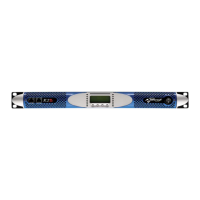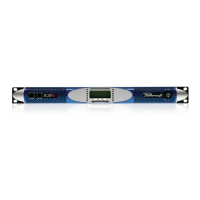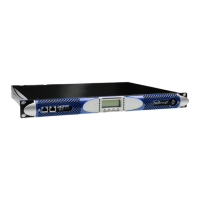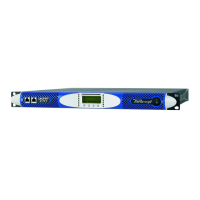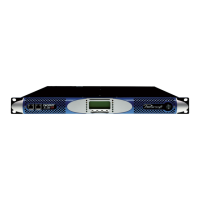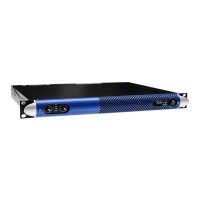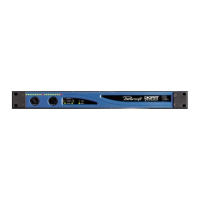8.1 The DSP Processing Chain
The core of the KDSP board is an advanced digital sound processor
based on a oating point SHARC® processor. FIGURE 38 shows
a block diagram of the DSP processing chain.
lock
mute mute menu
CH1 READY
V I MUTED
FIGURE 36: Right channel muted, left channel unmuted. Toggle mute
status by pressing the “mute” button
7.9 Idle Mode
The idle mode function is a power saving feature. When this
function is activated, the output stage is turned off after no input
signal greater than -60dBV approximately is detected for a user
selectable amount of time, saving about 40W of power per
channel (see the table in “7.7 Gate CH1 - CH2” on page 21 for
the exact wake up from idle voltage values) This results in reduced
heating, longer amplier and fans life, and, especially for xed
installations which are permanently turned on, a lower electricity
bill. Exiting from idle mode is quasi-instantaneous.
In order to set the time after which the amplier enters in idle
mode, push the right most button labelled “sel” when the idle
mode line is highlighted. This will open the “Idle state timeout”
screen. Using the central buttons, select the desired time. In the
“slow” mode, a single button press will increase or decrease the
time by one minute. The “fast” mode will bring this up to 10
minute steps. The timeout range goes from 0 to 720 minutes.
Idle state timeout
ok -
+
22 min
slow
FIGURE 37: Idle timeout set to 22 minutes
8 DSP Settings
The KDSP is a digital signal processing (DSP) add-on board for
Powersoft K Series ampliers. KDSP can be used to optimize the
performance of the audio system by means of fully customizable
crossovers and equalizers. Exceptionally high reliability is
guaranteed in all conditions by advanced limiters, and continuously
monitored loudspeaker parameters. This chapter illustrates the
features and operational modes of the KDSP board.
8.2 DSP Settings Menu
The DSP settings menu is subdivided in single channel settings or
“common” settings affecting both channels.
8.2.1 Common Settings
8.2.1.1 Source Selection
This menu allows to choose the input signal to be processed by
the DSP. The possible options are:
▶
Stereo: the signal coming from channel 1 is processed and
routed out to output channel 1. Similarly, the input signal
coming from Channel 2 is processed and then routed out to
output channel 2.
▶
Parallel from CH1: the input signal from channel 1 feeds two
parallel, distinct and independent processing branches. The
result of one branch is sent to output channel 1, while the
result of the other branch is sent to output channel 2.
▶
Parallel from CH2: the input signal from channel 2 feeds two
parallel, distinct and independent processing branches. The
result of one branch is sent to output channel 1, while the
result of the other branch is sent to output channel 2.
▶
Mono Mix: the input signals from channel 1 and 2 are
summed together and divided by two in order to maintain a
consistent output level. This mono mix signal is fed to both
output channels.
8.2.1.2 AES3
This menu controls the AES3 input stream options. The AES3
source can enter the amplier from the rear XLR or from the
KAESOP board (if present) based on the type of input selection
(see “7.3 Input select” on page 20).
8.2.1.3 Gain trim (dB)
This menu allows the user to set the gain to be applied to the
signal coming from the AES3 digital input. Setting a 0dB gain makes
the full-scale digital signal equivalent to an analog input signal of
20dBu.
8.2.1.4 If no link
This menu controls the amplier’s behavior should the AES3 signal
connection fail or become unreliable. The AES3 connection is
considered unreliable when transmission errors are greater than
1% of total data transmitted. The possible options are:
▶
Mute: when the AES3 connection fails, the amplier mutes
the output.
▶
Analog: when the AES3 connection fails, the amplier will rely
on the analog input as backup. This source signal switching is
done in real time in order to avoid any glitches in the audio
feed. If the input levels are correctly matched between analog
input and AES3 input (use the AES3 Gain trim parameter),
the switch between AES3 and analog will be inaudible.

